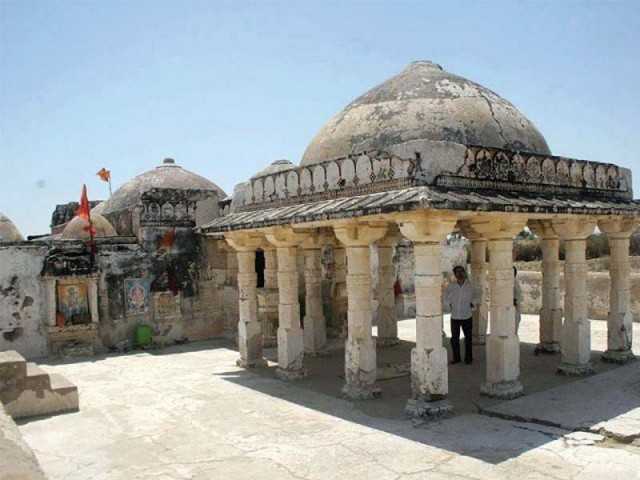Despite past grandeur, temple of Gori stands abandoned in Tharparkar
Built by wealthy Jains, the place of worship has seen many ups and downs

Built by wealthy Jains, the place of worship has seen many ups and downs.
Even for a cool January, Tharparkar was exceptionally hot during the day and a stopover at the temple of Gori near Nagarparkar was a welcoming respite, with its glowing white structure affording a pleasant shade. The abandoned temple, which now echoes with the screams of bats that cling to the inside of its domes, has survived through ups and downs of centuries and as urban visitors scurry around to take pictures of this spectacular site, a local tells us the tales of its glorious past and gloomy present. However with no caretaker around, the story of this place of worship remains a blur.

With the name Tharparkar now almost synonymous to suffering and deprivation, the desert and its numerous miseries grip the popular imagination today. The present is so depressing that only a few venture into exploring its past. Speaking to The Express Tribune, historian Kaleemullah Lashari says because of its challenging geography, Tharparkar remained an ignored land even when many kingdoms and empires flourished all over India. “It was a non-conventional area yielding lesser revenue than other parts of the country,” he explains.
A pre-Partition mandir and the struggle to protect it

However, it was not always futile. Lashari says around 2,000 years ago the region economically flourished due to the presence of an inland port in the area. “A creek, following the path of ancient river Sarasvati, created a harbour in the desert and helped traders dock their ships there,” he explains. The creek, Lashari believes, crossed Nagarparkar and reached till Virawah.
The historian says because of the harbour, which existed till the 15th century, a class of traders thrived in the area and history tells us, they were mainly followers of Jain - an ancient Indian religion. Hence, the abundance of Jain temples in the area.
Apart from being rich, Lashari says Jains were also devoted to their beliefs and raised many temples where they lived. “In Virawah alone, there are ruins of ten temples; two of them are still standing while others are at various stages of deterioration. There are a few in both Bodehsar and Nagarparkar city,” he tells us.
Divine design
Anthropologist Zulfiqar Ali Kalhoro says the temple has a typical Jain architecture similar to the ones in Mount Abu, Rajasthan, India, which are world-famous for their stunning use of marble. “Gori temple is a rectangular structure with a big central dome and 24 smaller domes around it. The cells under the smaller domes were used to store images of the 24 saints of Jain religion,” he explains. The Jain saints are called tirthankaras with Rishaba being the first one and Mahavira - the most popular saint - being the last and the 24th.
US to provide $250,000 to rehabilitate Varun Dev Temple

The anthropologist, who is also the author of the book ‘Art and Architecture of Sindh’, says the iconography inside the temple indicate the temple was dedicated to the 23rd tirthankara Parshvanatha. “His image was placed under the big central dome,” Kalhoro tells us.
The entrance to the main temple is through a spectacular white canopy standing on ten solid white pillars. Contrary to popular knowledge, Kalhoro claims the pillars are not made of marble but of limestone. “They are brilliantly whitewashed and that is what gives them the shiny look,” he says. The fresco inside the canopy, Kalhoro adds, is a scene from the wedding procession of the 22nd tirthankara Neminatha, which was attended by Hindu deity Krishna. “According to Jain beliefs, Neminatha and Krishna were cousins and the painting reflects that,” he says.
Kalhoro adds that the colours and techniques used to paint the fresco reveal the painting is not as old as the temple itself and were most likely done in 18th century.
Inside the temple, one cannot help but notice compact square compartments which the local accompanying us said were used to house worshippers. Historian Lashari says pundits, yogis and sanyasis travelled to the temple and stayed there to worship with devotion and concentration. “Traveling for salvation is an old part of human psychology and pilgrimage is believed to be the highest form of worship. The temple hosted many such holy worshippers,” he explains.
Celebrating the rich intellectual heritage of Sindh

Speaking about the damages the temple underwent, Lashari says the building had been severely harmed by earthquakes three times in recorded history, with the latest being in 2006 whose epicenter was in Rann of Kutch. “It left many cracks on the building; however it was not as bad as the one which had hit the temple during the British era. The tremor caused serious damages to the top portion of the temple,” he shares.
The temple was subjected to repairs before and during the British period and Lashari points out that pictures inside the temple were retouched in a European style. “If you closely look at the interior, you will notice the paintings inside were retouched by painters influenced by European artwork,” he says.
The reign of Gori
Despite being followers of two distinct religions, historian Lashari says Hindus and Jains in this region venerated each other’s gods and goddesses equally. “The different religious and ethnic communities of Tharparkar - which included Rajputs, Bheel and Mangwar - were not at odds with each other and lived in harmony,” he says, adding that because Tharpaprkar was an isolated area, there was also no intervention on part of the ruling elite. Lashari says the absence of a powerful central authority and Jains being the wealthy class meant the area was dominated by Jain temples, which were respected and visited by all the communities.
Lashari says the statue of Gori, which is connected to Hindu deities, was brought and placed in an already existing Jain temple in the 14th Century. “Temple of Gori, hence, is not the original name of the temple but a label it got after the statue was placed inside,” he explains.

“We don’t find temples of Gori anywhere in Pakistan; there are many for Shiv, Ram and Vishnu but none for Gori and the presence of one in Tharparkar only confirms it was a deviation from what mainstream Jain temples were like,” Lashari adds.
Diwali: A festival of lights in the city of lights
The statue was brought to this region by a merchant and placed inside the Jain temple as per the divine instructions he received in his dreams. “The presence of Gori revived the temple where rich paid hefty donations for viewing the statue while poor were hosted to free meals,” he says.
Little before the British arrived, however, the statue disappeared and the temple again lost its value.
“The temple has a checkered history; it has seen many rise and falls but the last 300 years have been only of deterioration and degradation,” Lashari laments.

Anthologist Kalhoro says the temple was looked after by Jains till the 1970s. “During my research, I learnt the last Jain family which lived here at least till 1972 would pay to free animals designated for sacrifice during Eidul Azha, in accordance to their belief of non-violence in action and thought,” Kalhoro shares.
While the beautiful temple stands tall today, the statue of Gori is long gone now and when you visit the temple, you will find pictures - not statues - of Shiv, Parvati and Ganesh placed inside the temple. Lashari says with changing time and population, the temple now fulfills the requirement of those currently living around it.
The writer is a staff member who visited Tharparkar as part of a trip organised by Pakistan Council of Media Women.
Published in The Express Tribune, February 11th, 2016.


















COMMENTS
Comments are moderated and generally will be posted if they are on-topic and not abusive.
For more information, please see our Comments FAQ